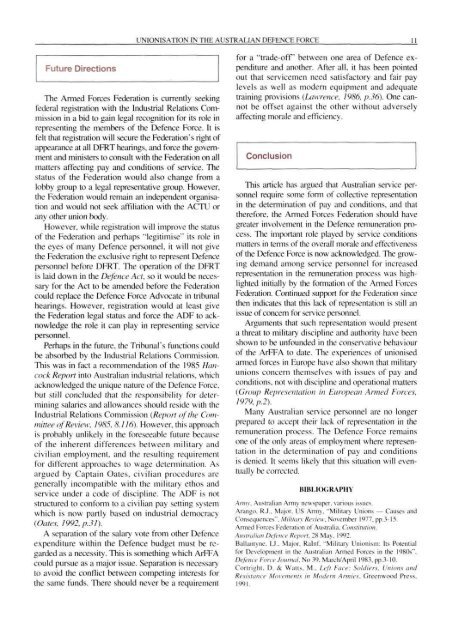ISSUE 107 : Jul/Aug - 1994 - Australian Defence Force Journal
ISSUE 107 : Jul/Aug - 1994 - Australian Defence Force Journal
ISSUE 107 : Jul/Aug - 1994 - Australian Defence Force Journal
Create successful ePaper yourself
Turn your PDF publications into a flip-book with our unique Google optimized e-Paper software.
UNIONISATION IN THE AUSTRALIAN DEFENCE FORCEIIFuture DirectionsThe Armed <strong>Force</strong>s Federation is currently seekingfederal registration with the Industrial Relations Commissionin a bid to gain legal recognition for its role inrepresenting the members of the <strong>Defence</strong> <strong>Force</strong>. It isfelt that registration will secure the Federation's rightofappearance at all DFRT hearings, and force the governmentand ministers to consult with the Federation on allmatters affecting pay and conditions of service. Thestatus of the Federation would also change from alobby group to a legal representative group. However,the Federation would remain an independent organisationand would not seek affiliation with the ACTU orany other union body.However, while registration will improve the statusof the Federation and perhaps '"legitimise" its role inthe eyes of many <strong>Defence</strong> personnel, it will not givethe Federation the exclusive right to represent <strong>Defence</strong>personnel before DFRT. The operation of the DFRTis laid down in the <strong>Defence</strong> Act, so it would be necessaryfor the Act to be amended before the Federationcould replace the <strong>Defence</strong> <strong>Force</strong> Advocate in tribunalhearings. However, registration would at least givethe Federation legal status and force the ADF to acknowledgethe role it can play in representing servicepersonnel.Perhaps in the future, the Tribunal's functions couldbe absorbed by the Industrial Relations Commission.This was in fact a recommendation of the 1985 HancockReport into <strong>Australian</strong> industrial relations, whichacknow ledged the unique nature of the <strong>Defence</strong> <strong>Force</strong>,but still concluded that the responsibility for determiningsalaries and allowances should reside with theIndustrial Relations Commission (Report of the Committeeof Review, 1985. 8.116). However, this approachis probably unlikely in the foreseeable future becauseof the inherent differences between military andcivilian employment, and the resulting requirementfor different approaches to wage determination. Asargued by Captain Oates. civilian procedures aregenerally incompatible with the military ethos andservice under a code of discipline. The ADF is notstructured to conform to a civilian pay setting systemwhich is now partly based on industrial democracy(Oates. 1992. pJl).A separation of the salary vote from other <strong>Defence</strong>expenditure within the <strong>Defence</strong> budget must be regardedas a necessity. This is something which ArFFAcould pursue as a major issue. Separation is necessaryto avoid the conflict between competing interests forthe same funds. There should never be a requirementfor a "trade-off between one area of <strong>Defence</strong> expenditureand another. After all. it has been pointedout that servicemen need satisfactory and fair paylevels as well as modem equipment and adequatetraining provisions (Lawrence, 1986, p.36). One cannotbe offset against the other without adverselyaffecting morale and efficiency.ConclusionThis article has argued that <strong>Australian</strong> service personnelrequire some form of collective representationin the determination of pay and conditions, and thattherefore, the Armed <strong>Force</strong>s Federation should havegreater involvement in the <strong>Defence</strong> remuneration process.The important role played by service conditionsmatters in terms of the overall morale and effectivenessof the <strong>Defence</strong> <strong>Force</strong> is now acknowledged. The growingdemand among service personnel for increasedrepresentation in the remuneration process was highlightedinitially by the formation of the Armed <strong>Force</strong>sFederation. Continued support for the Federation sincethen indicates that this lack of representation is still anissue of concern for service personnel.Arguments that such representation would presenta threat to military discipline and authority have beenshown to be unfounded in the conservative behaviourof the ArFFA to date. The experiences of unionisedarmed forces in Europe have also shown that militaryunions concern themselves with issues of pay andconditions, not with discipline and operational matters(Group Representation in European Anned <strong>Force</strong>s,1979. p.2).Many <strong>Australian</strong> service personnel are no longerprepared to accept their lack of representation in theremuneration process. The <strong>Defence</strong> <strong>Force</strong> remainsone of the only areas of employment where representationin the determination of pay and conditionsis denied. It seems likely that this situation will eventuallybe corrected.BIBLIOGRAPHYArmy, <strong>Australian</strong> Army newspaper, various issues.Arango. R.J.. Major. US Army. "Military Unions — Causes andConsequences". Military Review. November 1477. pp.3-15.Armed <strong>Force</strong>s Federation of Australia. Constitution.<strong>Australian</strong> <strong>Defence</strong> Report. 28 May. 1992.Ballantyne, I.J.. Major. Ralnf. "Military Unionism: Its Potentialfor Development in the <strong>Australian</strong> Armed <strong>Force</strong>s in the 1980s".<strong>Defence</strong> <strong>Force</strong> <strong>Journal</strong>. No 39. March/April 1983. pp.3-10.Cortright. D. & Watts. M.. Left Face: Soldiers. Unions andResistance Movements in Modern Annies. Greenwood Press.1991.
















